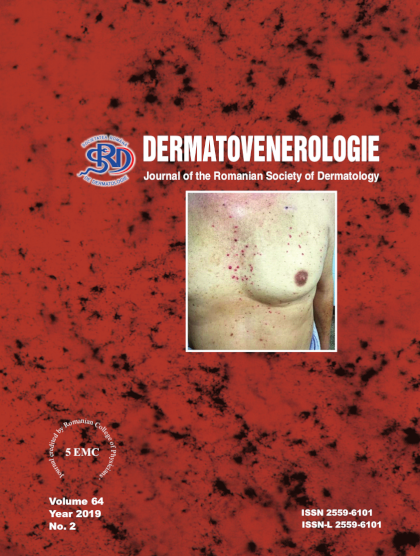Introducere: Deși legătura rozaceei cu sistemul
cardiovascular este bine cunoscută, flushing-urile faciale și
dezvoltarea telangiectaziilor fiind două dintre simptomele
primare cutanate ale rozaceei, date recente indică o
potențială conexiune între rozacee și boala cardiovasculară.
Obiectiv: Evaluarea riscului de boală cardiovasculară
prin identificarea factorilor de risc cardiovascular la
pacienții cu rozacee.
Material și metodă: Am realizat un studiu cazcontrol
în care au fost incluși 46 de pacienți cu rozacee (37
femei și 9 bărbați, vârsta medie 49,8+15,18 ani) și 39
subiecți martor fără rozacee (31 femei și 8 bărbați, vârsta
medie 47,87+15,11 ani) cu caracteristici asemănătoare de
vârstă și sex cu cei din lotul de studiu. Au fost înregistrate
datele demografice, datele antropometrice, istoricul medical
și prezența factorilor de risc cardiovascular. La pacienții cu
rozacee au fost colectate date privind vechimea bolii și
subtipul clinic de rozacee. Au fost efectuate următoarele
investigații de laborator: glicemie, insulină, profil lipidic,
CRP. Au fost calculate indicele HOMA-IR și scorul de risc
Framingham.
Rezultate: 27 (58,69%) dintre pacienții cu rozacee
prezentau forma clinică de rozacee eritematotelangiectazică
iar 19 (41,31%) aveau rozacee papulopustuloasă.
Durata de evoluție a rozaceei a avut o medie de
10,85+9,08 ani. S-a observat o frecvență mai ridicată a
HTA (p=0.004), a valorilor scăzute ale HDL colesterolului
(p=0.037), a CRP (p=0.028) și a sindromului metabolic
(p=0.047) la pacienții cu rozacee comparativ cu lotul
martor, rezultate care s-au asociat cu un risc mai ridicat de
boală cardiovasculară și deces conform scorului de risc
Framingham (p=0.001). Nu s-a identificat o corelație a
formelor clinice de rozacee cu factorii de risc cardiovascular.
Concluzii:
Pacienții cu rozacee asociază mai frecvent
factori de risc cardiovascular comparativ cu subiecții
martor, impunând o evaluare sistematică a acestora datorită
riscului crescut pentru bolile cardiovasculare și deces.


